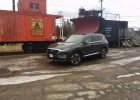
By Kevin Harrison
I’m not quite sure why Hyundai’s two efforts in the 7+ passenger seating segment didn’t pan out.
They tried their luck entering the minivan segment with the Entourage which, seemingly was a decent effort against cheap minivans like the Dodge Grand Caravan. But Caravan sales plus the overall plushness and techy-ness of more expensive vans like the Honda Odyssey and Toyota Sienna pretty much wiped the Entourage off most minivan shopping lists.
So, thinking that most people still thought minivans were uncool, Hyundai decided to play its cards in the larger three row crossover segment. I’m not sure what happened there either since the Veracruz offered decent luxury, style (okay, maybe it was too similarly styled to others in the segment) and value. Today, I do a double take when I see a Veracruz on the road because they are that rare.
But those two failed ventures didn’t stop Hyundai from trying. They’re hoping their latest offering will be the third time’s a charm moment they’ve been looking for. So, here we have a completely new three seater crossover with a new, but familiar name and I had the keys for a week.
How does it fair?
Well first things first, Hyundai decided to take an existing design of the new Santa Fe and stretch it. Usually longer wheelbase vehicles don’t end up nearly as nice looking as the original vehicle they were based on, but the Santa Fe XL does a fairly decent job. I love the unique-to-Canada rims, as well as that clean, attractive and bold front end. Rear end styling is fine, but nothing to get too excited about.
When you see the features that come on the Santa Fe XL, you will be excited though. Leather, heated steering wheel, a massive glass panoramic roof among other things. My only issue, which admittedly is usually an issue with most Hyindais, is that the leather feels rather cheap. So much so, that it had me double check to make sure it was real leather and not leatherette. And while that panoramic roof is nice, the controls for it and its accompanying shade are irritating. Why can’t I just have it open and close and that’s it? Each time I wanted to close the roof, it would close the shade along with it. No. I want the shade open but the roof closed. Similarly, if the roof is tilted and I wanted it open, it won’t open it until you close the tilt. After doing so, you then need to open it. These may seem like minor issues, but it becomes a real problem when you are trying to operate the sunroof while in motion.
The good news is that the layout is quite attractive and the controls are logically laid out. I’d prefer a larger display screen than what comes on the centre stack (it’s tiny) but despite that, the font is clear and easy to read. The seats are fairly comfortable but I’d prefer more side bolstering, but there is good head, knee and leg room in all three rows and entrance to the third row is quite good. Cargo space with the third row up, while not plentiful, is adequate for a few bags. When you have all three rows down, you can essentially put a blow up mattress in there and spend the night. There’s a lot of room.
The even better news comes in the form of the engine. It produces 290 horsepower which, for a vehicle this size may not seem like a lot, but then there’s the weight figure. The Santa Fe XL comes in at around 4,100 pounds. To give you an idea of how light that actually is, one of the Santa Fe’s competitors, the Dodge Durango, weighs around 4,700 pounds. That means that it can make due with under 300 horses yet still remains quick on its feet all while returning decent fuel efficiency due to the weight loss – in theory. I say in theory because weight loss usually translates into fuel savings but this wasn’t really the case during my week of testing.
I averaged 15.1 L/100 kms in mostly city driving. The Santa Fe’s official numbers are 13.2 L/100 kms city and about 9.8 L/100 kms highway. While my real world fuel consumption numbers aren’t terribly far off the mark, it does beg the question why a vehicle so light weight would produce hefty numbers. Well, there are a few factors here. Firstly, I noticed when taking off, the automatic likes to rev up to higher RPM’s, presumably to get it going, but it also does so in second. Higher RPM’s = more fuel consumption. Secondly, there wasn’t a terribly large amount of kilometers on the odometer which means the engine likely wasn’t really ‘broken in’ yet. These factors can contribute to the realized fuel efficiency numbers.
Since handling isn’t the forte of any 4,000 vehicle of this size, I won’t judge it too harshly, but I will say that it can handle the concrete jungle quite decently. You aren’t going to be able to take a corner without breaking, but you also don’t get the sensation that you may roll over either. The suspension is a bit wallowy over larger bumps – a Hyundai trait unfortunately, but on smooth surfaces the ride is, well, smooth.
All in all this is one of the best efforts yet from the Korean automaker in making a 7-passenger hauler. The other offerings were good, but this Santa Fe XL shows that Hyundai truly means business. And it’s hoping not only that you’ll choose it over its competition, but it’s also hoping you’ll choose it over a minivan. Regardless of your choice between the two segments, the Santa Fe XL should be on your list.
Price As Tested: $39,199
Pros:
- Value/standard features
- Interior Space
- Exterior looks
- Decent power
Cons:
- Cheap feeling leather
- Fidgety sunroof
- Small display screen
- Fuel consumption
Immediate Competition:
- Chevrolet Traverse
- Dodge Durango
- Ford Explorer
- Honda Pilot
- Mazda CX-9
- Nissan Pathfinder
- Toyota Highlander
Overall 7/10












